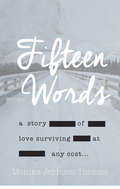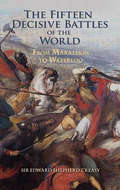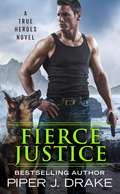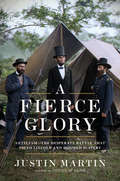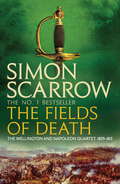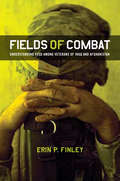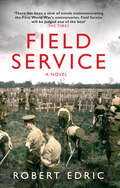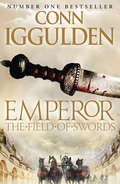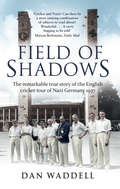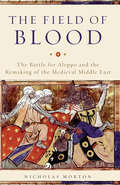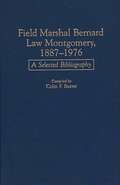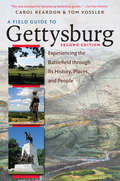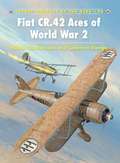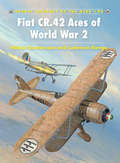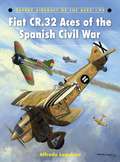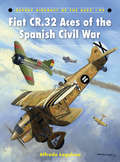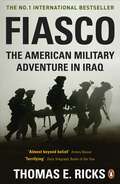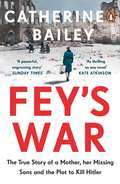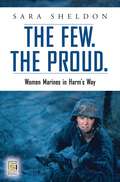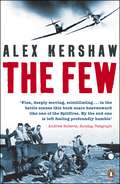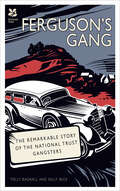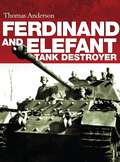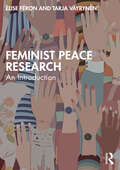- Table View
- List View
Fifteen Words
by Monika Jephcott ThomasTwo young doctors form a profound and loving bond in Nazi Germany; a bond that will stretch them to the very limits of human endurance. Catholic Max - whose religious and moral beliefs are in conflict, has been been conscripted to join the war effort as a medic, despite his hatred of Hitler’s regime. His beloved Erika, a privileged young woman, is herself a product of the Hitler Youth. In spite of their stark differences, Max and Erika defy convention and marry. But when Max is stationed at the fortress city of Breslau, their worst nightmares are realised; his hospital is bombed, he is captured by the Soviet Army and taken to a POW camp in Siberia. Max experiences untold horrors, his one comfort the letters he is allowed to send home: messages that can only contain Fifteen Words. Back in Germany, Erika is struggling to survive and protect their young daughter, finding comfort in the arms of a local carpenter. Worlds apart and with only sparse words for comfort, will they ever find their way back to one another, and will Germany ever find peace? Fifteen Words is a vivid and intimate portrayal of human love and perseverance, one which illuminates the German experience of the war, which has often been overshadowed by history.
The Fifteen Decisive Battles of the World: From Marathon to Waterloo (Dover Military History, Weapons, Armor Ser.)
by Edward Shepherd CreasyRanging from Marathon to Waterloo, this classic of military history chronicles battles that changed the course of history. Originally published in 1851, at the zenith of British imperial power, it found an eager audience of readers who wanted to understand how Britain had achieved its tremendous influence and how long it would last. Since then, these chronicles of ancient and modern military confrontations have informed and inspired generations of students and armchair historians.Educated at Eton College and the University of Cambridge, Sir Edward Shepherd Creasy was called to the Bar in 1837, appointed to the faculty of the University of London in 1840, and served as Chief Justice of Ceylon from 1860 to 1870. Creasy's scholarship and literary skill are complemented by his judicial attitude, which endows this book with a fair-minded, nonpartisan approach. He prefaces each battle with an introduction that explains the circumstances surrounding the war, as well as an afterword that considers how history might have changed had victory gone to the other side. Linking passages offer valuable insights into historical events that occurred between the major encounters. Influential and ever-popular, this book offers authoritative and entertaining analyses of the conflicts that shaped world history.
Fierce Justice (True Heroes #5)
by Piper J. DrakeReal heroes aren't born, they're madeK9 handler Arin Siri doesn't like taking orders, and she works best when it's just her and her dog King out in the field. But when she discovers a wounded soldier of fortune during a Search and Protect mission, she has no choice but to get him to safety. The last time she and the roguish, sexy Jason Landon tangled, they were on opposite sides of the conflict, but this time, he's claiming to need her help.When Jason wakes up in a hospital on Hawaii's Big Island, he's shocked to discover Arin guarding him. She's the last person he expected to see, but she's also the only person who can help him bring down a kidnapping ring. As they draw closer to danger-and to each other-they must race against the clock to discover who the kidnappers are working for, or risk becoming collateral damage themselves.
A Fierce Glory: Antietam--The Desperate Battle That Saved Lincoln and Doomed Slavery
by Justin MartinOn September 17, 1862, the "United States" was on the brink, facing a permanent split into two separate nations. America's very future hung on the outcome of a single battle--and the result reverberates to this day. Given the deep divisions that still rive the nation, given what unites the country, too, Antietam is more relevant now than ever. The epic battle, fought near Sharpsburg, Maryland, was a Civil War turning point. The South had just launched its first invasion of the North; victory for Robert E. Lee would almost certainly have ended the war on Confederate terms. If the Union prevailed, Lincoln stood ready to issue the Emancipation Proclamation. He knew that freeing the slaves would lend renewed energy and lofty purpose to the North's war effort. Lincoln needed a victory to save the divided country, but victory would come at a price. Detailed here is the cannon din and desperation, the horrors and heroes of this monumental battle, one that killed 3,650 soldiers, still the highest single-day toll in American history. Justin Martin, an acclaimed writer of narrative nonfiction, renders this landmark event in a revealing new way. More than in previous accounts, Lincoln is laced deeply into the story. Antietam represents Lincoln at his finest, as the grief-racked president--struggling with the recent death of his son, Willie--summoned the guile necessary to manage his reluctant general, George McClellan. The Emancipation Proclamation would be the greatest gambit of the nation's most inspired leader. And, in fact, the battle's impact extended far beyond the field; brilliant and lasting innovations in medicine, photography, and communications were given crucial real-world tests. No mere gunfight, Antietam rippled through politics and society, transforming history.A Fierce Glory is a fresh and vibrant account of an event that had enduring consequences that still resonate today.
The Fields of Death: (Revolution 4) (The Wellington and Napoleon Quartet #4)
by Simon ScarrowTHE FIELDS OF DEATH is the epic final novel in Simon Scarrow's bestselling Wellington and Napoleon Quartet. Essential reading for fans of Bernard Cornwell.1809. Viscount Wellington and Emperor Napoleon Bonaparte have made their mark as military commanders. Lifelong enemies, they both believe their armies are strong enough to destroy any rival. But in war victory can never be certain.While Wellington's success continues in Spain, Napoleon feels the sting of failure. Yet despite a disastrous Russian campaign and humiliating defeat at Leipzig, he persists in fighting on.With Napoleon's power waning, the newly titled Duke of Wellington is perfectly placed to crush the tyrant. But his enemy refuses to surrender, and so the two giants must face a final reckoning on the bloody battlefield of Waterloo...
Fields of Combat: Understanding PTSD among Veterans of Iraq and Afghanistan (The Culture and Politics of Health Care Work)
by Erin P. Finley"If you consider Iraq—like I do, probably twenty-nine out of thirty days—to be the pinnacle of your life, then where do you go from there? And I'm sure that a lot of veterans feel that way. To them, that was it. That was everything. So now what? They have to find something meaningful and purposeful.""When I got back from Afghanistan, there was not even so much as a briefing that said, 'Let us know if you're having problems.' There wasn't so much as a phone number. There was literally nothing.""I knew it was crazy. I was thinking, the guy on the roof's either a sniper or he's going to radio ahead. And then I thought, this is San Antonio. There's not snipers on the roof, nobody's going to blow me up here.""Whenever I look at people back here at home, I know what they're going to look like dead. I know what they look like with their brains blown out or jaws blown off or eyes pulled out. When I look at somebody I see that, to this day."—Voices of veterans interviewed in Fields of CombatFor many of the 1.6 million U.S. service members who have served in Iraq and Afghanistan since 2001, the trip home is only the beginning of a longer journey. Many undergo an awkward period of readjustment to civilian life after long deployments. Some veterans may find themselves drinking too much, unable to sleep or waking from unspeakable dreams, lashing out at friends and loved ones. Over time, some will struggle so profoundly that they eventually are diagnosed with post-traumatic stress Disorder (PTSD).Both heartbreaking and hopeful, Fields of Combat tells the story of how American veterans and their families navigate the return home. Following a group of veterans and their personal stories of war, trauma, and recovery, Erin P. Finley illustrates the devastating impact PTSD can have on veterans and their families. Finley sensitively explores issues of substance abuse, failed relationships, domestic violence, and even suicide and also challenges popular ideas of PTSD as incurable and permanently debilitating. Drawing on rich, often searing ethnographic material, Finley examines the cultural, political, and historical influences that shape individual experiences of PTSD and how its sufferers are perceived by the military, medical personnel, and society at large. Despite widespread media coverage and public controversy over the military's response to wounded and traumatized service members, debate continues over how best to provide treatment and compensation for service-related disabilities. Meanwhile, new and highly effective treatments are revolutionizing how the Department of Veterans Affairs (VA) provides trauma care, redefining the way PTSD itself is understood in the process. Carefully and compassionately untangling each of these conflicts, Fields of Combat reveals the very real implications they have for veterans living with PTSD and offers recommendations to improve how we care for this vulnerable but resilient population.
Field Service
by Robert EdricMorlancourt, Northern France, 1920In the aftermath of the world's bloodiest conflict, a small contingent of battle-worn soldiers remains in France. Captain James Reid and his men are tasked with the identification and burial of innumerable corpses as they come to terms with the events of the past four years.The stark contrast between the realities of burying men in France and the reports of honouring the dead back in Britain is all too clear. But it is only when the daily routine is interrupted by a visit from two women, both seeking solace from their grief, that the men are forced to acknowledge the part they too have played.With his trademark unerring precision, Robert Edric explores the emotional hinterland which lies behind the work done by the War Graves Commission in the wake of the First World War.
The Field of Swords: A Novel Of Julius Caesar (Emperor Series #3)
by Conn IgguldenThe ultimate Rome story
Field of Shadows: The English Cricket Tour of Nazi Germany 1937
by Dan WaddellAdolf Hitler despised cricket, considering it un-German and decadent. And Berlin in 1937 was not a time to be going against the Fuhrer’s wishes. But hot on the heels of the 1936 Olympics, an enterprising cricket fanatic of enormous bravery, Felix Menzel, somehow persuaded his Nazi leaders to invite an English team to play his motley band of part-timers.That team was the Gentlemen of Worcestershire, an ill-matched group of mavericks, minor nobility, ex-county cricketers, rich businessmen and callow schoolboys – led by former Worcestershire CC skipper Major Maurice Jewell. Ordered ‘not to lose’ by the MCC, Jewell and his men entered the 'Garden of Beasts' to play two unofficial Test matches against Germany. Against a backdrop of repression, brutality and sporadic gunfire, the Gents battled searing August heat, matting pitches, the skill and cunning of Menzel, and opponents who didn't always adhere to the laws and spirit of the game. The tour culminated in a match at the very stadium which a year before had witnessed one of sport's greatest spectacles and a sinister public display of Nazi might. Despite the shadow cast by the cataclysmic conflict that was shortly to engulf them, Dan Waddell's vivid and detailed account of the Gentlemen of Worcestershire's 1937 Berlin tour is a story of triumph: of civility over barbarity, of passion over indifference and hope over despair.
The Field of Blood: The Battle for Aleppo and the Remaking of the Medieval Middle East
by Nicholas MortonA history of the 1119 Battle of the Field of Blood, which decisively halted the momentum gained during the First Crusade and decided the fate of the Crusader statesDuring the First Crusade, Frankish armies swept across the Middle East, capturing major cities and setting up the Crusader States in the Levant. A sustained Western conquest of the region appeared utterly inevitable. Why, then, did the crusades ultimately fail?To answer this question, historian Nicholas Morton focuses on a period of bitter conflict between the Franks and their Turkish enemies, when both factions were locked in a struggle for supremacy over the city of Aleppo. For the Franks, Aleppo was key to securing dominance over the entire region. For the Turks, this was nothing less than a battle for survival--without Aleppo they would have little hope of ever repelling the European invaders. This conflict came to a head at the Battle of the Field of Blood in 1199, and the face of the Middle East was forever changed.
Field Marshal Bernard Law Montgomery, 1887-1976: A Selected Bibliography (Bibliographies of Battles and Leaders)
by Colin F. BaxterIn the desperate summer of 1942, Hitler seemed to be on the verge of victory in Russia and the Middle East. With Rommel nearing Cairo, a little known lieutenant-general, Bernard Montgomery, took charge of what Churchill called a baffled and bewildered British 8th Army. Assuming command, Montgomery issued his famous order, Here we will stand and fight;…If we can't stay here alive, then let us stay here dead, and led the Army to one of the Allies' greatest victories—El Alamein. Monty became an instantly recognizable Allied leader, but as a man with strong views, unbending principles, and outspoken frankness, he was both loved and disliked, praised and criticized. This bibliography presents and evaluates the extensive body of literature that has grown up around the controversial Field Marshal.Any serious study of World War II military campaigns must confront Field Marshal Bernard Montgomery, an individualist with both admirers and detractors. This book provides an extensive historiographical overview of the literature in Part I and a bibliography of significant works in Part II. It is a basic reference and research guide for the student, scholar, and general reader.
A Field Guide to Gettysburg, Second Edition Expanded Ebook: Experiencing the Battlefield through Its History, Places, and People
by Carol Reardon Tom VosslerThis special enhanced ebook edition to the newly updated A Field Guide to Gettysburg will lead visitors to every important site across the battlefield and also give them ways to envision the action and empathize with the soldiers involved and the local people into whose lives and lands the battle intruded.. Both Carol Reardon and Tom Vossler are themselves experienced guides who understand what visitors to Gettysburg are interested in, but they also bring the unique perspectives of a scholar and a former army officer. Divided into three day-long tours, this newly improved and expanded edition offers important historical background and context for the reader while providing answers to six key questions: What happened here? Who fought here? Who commanded here? Who fell here? Who lived here? And what did the participants have to say about it later?With new stops, maps, soldier vignettes, and illustrations, the enhanced e-book edition of A Field Guide to Gettysburg adds more human stories to an already impressive work that remains the most comprehensive guide to the events and history of this pivotal battle of the Civil War.
Fiat CR.42 Aces of World War 2 (Aircraft of the Aces)
by Richard Caruana Ludovico Slongo Håkan GustavssonThe Fiat CR.42, a logical development of the Fiat CR.32, was the last single-seat fighter biplane to be produced. It entered service with the Italian Regia Aeronautica in May 1939 before being exported to Belgium, Hungary and Sweden. Its combat debut came when the Belgian air force threw its fleet into action during the German invasion of the Low Countries on 10th May 1940. Despite being quickly overwhelmed, the Belgian pilots managed to make a number of aerial claims. The CR.42 became heavily involved in the fighting in North Africa and although it was gradually replaced by more modern fighters, it continued in a point defence and ground support role until the end of the war. Drawing on research from a range of sources, this book examines the extensive employment of the Italian fighter plane during the course of World War II.
Fiat CR.42 Aces of World War 2 (Aircraft of the Aces)
by Richard Caruana Ludovico Slongo Håkan GustavssonThe Fiat CR.42, a logical development of the Fiat CR.32, was the last single-seat fighter biplane to be produced. It entered service with the Italian Regia Aeronautica in May 1939 before being exported to Belgium, Hungary and Sweden. Its combat debut came when the Belgian air force threw its fleet into action during the German invasion of the Low Countries on 10th May 1940. Despite being quickly overwhelmed, the Belgian pilots managed to make a number of aerial claims. The CR.42 became heavily involved in the fighting in North Africa and although it was gradually replaced by more modern fighters, it continued in a point defence and ground support role until the end of the war. Drawing on research from a range of sources, this book examines the extensive employment of the Italian fighter plane during the course of World War II.
Fiat CR.32 Aces of the Spanish Civil War (Aircraft of the Aces)
by Richard Caruana Alfredo LogolusoThe CR.32 Falco was a handsome and highly manoeuvrable biplane fighter. During General Franco's fight with the Republicans for the control of Spain from 1936 – 39, no fewer than 477 CR.32s were involved, with an astounding 709 confirmed aerial victories, and an additional 320 kills claimed, for just 62 losses. As these statistics reveal, the CR.32 was the unrivalled master of the skies over Spain. By the war's end, the five leading aces of the conflict were all Spanish CR.32 pilots. Their exploits, and those of the other leading CR.32 aces, are examined for the first time in English in this exciting volume.
Fiat CR.32 Aces of the Spanish Civil War (Aircraft of the Aces #94)
by Richard Caruana Alfredo LogolusoThe CR.32 Falco was a handsome and highly manoeuvrable biplane fighter. During General Franco's fight with the Republicans for the control of Spain from 1936 – 39, no fewer than 477 CR.32s were involved, with an astounding 709 confirmed aerial victories, and an additional 320 kills claimed, for just 62 losses. As these statistics reveal, the CR.32 was the unrivalled master of the skies over Spain. By the war's end, the five leading aces of the conflict were all Spanish CR.32 pilots. Their exploits, and those of the other leading CR.32 aces, are examined for the first time in English in this exciting volume.
Fiasco: The American Military Adventure in Iraq
by Thomas E. RicksCutting through the headlines and spin, this is the first book to give us a true picture of the reality on the ground, through the words of the people there - from commanders to intelligence officers, army doctors to ordinary soldiers. Providing eye-witness accounts that contradict the official stories and figures, they give a chilling picture of the deceit, stupidity, wishful thinking, lack of forward planning and total intellectual failure of those behind the invasion. The result is an extraordinary new insight into the plight of ordinary soldiers doing nightmarish jobs, and the real nature of the fighting in Iraq.
Fey's War: The True Story of a Mother, her Missing Sons and the Plot to Kill Hitler
by Catherine Bailey**Formerly published as The Lost Boys**'As thrilling as any novel. Bailey has an extraordinary talent for bringing history to life' Kate Atkinson'Remarkable. A powerful, engrossing story of a journey into the heart of darkness and final escape from it' Sunday Times___________________________________________________________In September, 1944, the SS march into a remote Italian castle, arrest a mother and seize her two sons, aged just two and three. If Hitler has his way she will never see them again. For Fey Pirzio-Biroli is the daughter of Ulrich von Hassell, executed days before after the failed assassination of the Fuhrer. Mercilessly cast into the Nazi death machine, Fey must cling to the hope that one day she will escape and rescue her lost children . . .An extraordinary story of resistance at the heart of the Second World War, Fey's War is an illuminating and devastating true account of great personal sacrifice, of loss and, above all, of defiance.___________________________________________________________'Riveting, important, reads like a terrifying thriller' Daily Telegraph'Heartbreaking. It started with a plot to kill Hitler. It ended in one of the most astonishing and moving stories of the war' Daily Mail'Extraordinary. A rich, deep, gripping read' Guardian'As thrilling as any novel. Bailey has an extraordinary talent for bringing history to life' Kate Atkinson
The Few. The Proud.: Women Marines in Harm's Way (Praeger Security International)
by Sara SheldonOn a dark night in February 2005, Sara Sheldon arrived at Camp Fallujah, outside the dangerous ancient city for which it was named. Armed only with a camera, a laptop, and notepads, she was a spectator to the war who secured permission to embed with the 1st MEF and observe and interview Marines who happened to be women then posted at Camp Fallujah. In the time she spent there, Sheldon interviewed women who held ranks from corporal to colonel to gain a broad and varied perspective of the experiences representative of female Marines throughout Iraq. She reveals much about her subjects: the preconceived notions they possessed when they enlisted in the Corps, how the experience of serving in Iraq changed them, and what they ultimately took home from the battlefield.Americans are aware that women are actively serving in the armed forces, but few understand what exactly is expected of women in the military, the duties they perform, and the limitations and restrictions placed on them, especially in a combat zone. Sheldon reveals much about her subjects. In some ways, they mirrored their male counterparts. Some enlisted only for four years to receive educational benefits or for an opportunity to escape their home environment. Others made the Corps their career, serving as commissioned officers. Still others were recalled to active duty to serve with their representative Guard units. Sheldon uncovers their stories: the preconceived notions they possessed when they enlisted in the Corps, how the experience of serving in Iraq has changed them, and what they ultimately took home from the battlefield. She also sheds light on the day-to-day grind all American service personnel face in Iraq. Yet, she never loses her main focus. Far removed from the Green Zone, Sheldon and her subjects spent their days in harm's way, but she avoids a running commentary on policy. Instead, she remains committed to examining how women tasked with field duties and various missions at the lower levels of command are impacted by their experiences.
The Few: July-October 1940
by Alex KershawIn the early days of World War Two when Britain stood alone against the terror of Hitler's all-conquering Third Reich, her future hung in the balance; her defence in the hands of the Spitfires and Hurricanes of the Royal Air Force's Fighter Command. They were Churchill's Few. In defiance of their own country's strict neutrality laws, a handful of American adventurers flew with them. This is their story - and a fresh perspective on the greatest air battle the world has ever seen.
The Ferryman's Daughter: The gripping new family saga of strength, family and hope for fans of Josephine Cox and Sheila Newberry
by Juliet GreenwoodCan Hester help her family escape desperate poverty and fulfil her dreams?1908: Hester always loved her mother best, her father had always been a hard man to like, spending more time (and money) in the local than with his family. After her mother's sudden death, followed by an injury forcing her father to give up his job as the ferryman, Hester is placed in the position of care-giver for her young brother and sister. As the years pass Hester must row the ferry night and day to keep them all from starvation, while her hopes of working in a kitchen and one day becoming a cook, slip further and further away. But just how far is Hester willing to go to make her dream a reality? And as the threat of war comes ever closer to the Cornish coast, will it bring opportunities or despair for Hester and her family?
Ferguson's Gang
by Polly Bagnall Sally Beck1927. Britain’s heritage is vanishing. Beautiful landscapes are being bulldozed. Historic buildings are being blown up. Stonehenge is collapsing.
Ferdinand and Elefant Tank Destroyer (General Military Ser.)
by Thomas AndersonThis is the story of the largest and statistically most successful tank destroyer of World War II. The Ferdinand was a true behemoth, and although only 91 examples were built, they took a savage toll of Soviet armour in the Battle of Kursk and subsequent operations on the Eastern Front. This study explores the technical development and combat deployment of this remarkable vehicle, from its' origins in the Porsche Tiger Tank through its deployment under the designation 'Ferdinand' in the Citadel offensive, to its modification and redesignation as the 'Elefant' and final use in the desperate Battle of Berlin. Drawing on original archival material from within Germany, private collections and heretofore unpublished photographs this title is an essential illustrated history to one of the most famous armoured vehicles ever built.
Ferdinand and Elefant Tank Destroyer
by Thomas AndersonThis is the story of the largest and statistically most successful tank destroyer of World War II. The Ferdinand was a true behemoth, and although only 91 examples were built, they took a savage toll of Soviet armour in the Battle of Kursk and subsequent operations on the Eastern Front. This study explores the technical development and combat deployment of this remarkable vehicle, from its' origins in the Porsche Tiger Tank through its deployment under the designation 'Ferdinand' in the Citadel offensive, to its modification and redesignation as the 'Elefant' and final use in the desperate Battle of Berlin. Drawing on original archival material from within Germany, private collections and heretofore unpublished photographs this title is an essential illustrated history to one of the most famous armoured vehicles ever built.
Feminist Peace Research: An Introduction
by Élise Féron Tarja VäyrynenThis textbook provides a comprehensive overview of the field of gender, feminism and peace.It is based on the argument that feminist thinking is necessary to understand and analyse the core issues in peace and conflict studies and is fundamental to thinking about solutions to global problems and to promoting peaceful conflict transformation. The book centres alternative and critical approaches missing in mainstream peace research and brings forward feminist perspectives on traditional peace research topics such as militarism, peacekeeping, arms trade and the articulation of different forms of violence. It also advances critical and alternative issues and topics that traditional peace research has sidelined, including, for example, artificial intelligence, technologies and peace; trauma and memory; human–non-human species relations; art; popular culture; post-colonial and decolonial feminist perspectives; and the queering of war and peace. In sum, this textbook contributes to the visibility of these feminist critical approaches to peace research and makes them accessible to scholars and students interested in the subject.This book will be of much interest to students of peace studies, feminist theory, gender studies and International Relations.
